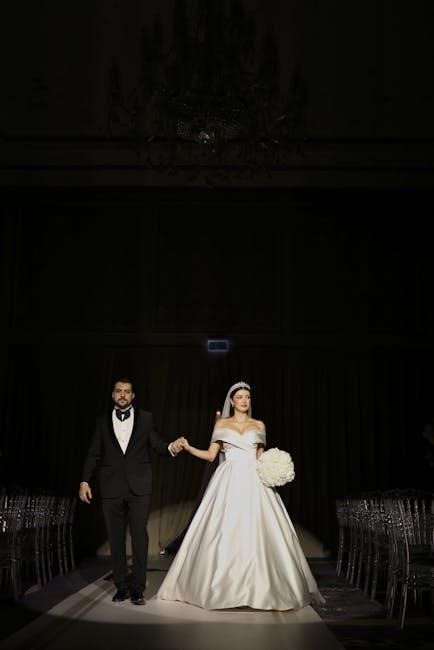Felix Mendelssohn’s Wedding March, from A Midsummer Night’s Dream, is a beloved orchestral piece. Composed in 1842, it features a grand brass introduction and a joyful melody, becoming a popular wedding processional worldwide.
1.1 Overview of the Wedding March
Felix Mendelssohn’s Wedding March, part of his A Midsummer Night’s Dream incidental music (Op. 61), is a iconic orchestral piece. Known for its grand brass fanfare and lively melody, it has become synonymous with wedding ceremonies worldwide. The march exudes joy and celebration, making it a timeless choice for bridal processions. Its structure features a triumphant opening, followed by a lyrical theme, culminating in a jubilant finale. The piece is widely performed in both traditional and modern weddings, showcasing its enduring appeal. Available in various arrangements, including piano, string quartet, and orchestral versions, the Wedding March remains a cornerstone of wedding music, reflecting Mendelssohn’s mastery of Romantic-era composition.
1.2 Historical Background of the Composition
Felix Mendelssohn composed the Wedding March in 1842 as part of the incidental music for Shakespeare’s A Midsummer Night’s Dream. The piece was first performed in Potsdam, Germany, and was initially intended for theatrical use, not weddings. Over time, its grand and celebratory nature led to its adoption in wedding ceremonies. Despite its association with weddings, Mendelssohn did not originally write it for this purpose. The march gained popularity in the late 19th century, becoming a standard choice for wedding processions. Its enduring appeal lies in its majestic brass fanfare and lyrical themes, which evoke joy and celebration. Today, it remains one of Mendelssohn’s most recognized works, bridging theatrical and matrimonial traditions.

Composition and Structure
Wedding March, part of Mendelssohn’s A Midsummer Night’s Dream Op. 61, is an orchestral composition featuring brass fanfares, lyrical strings, and woodwind accents. The piece is structured in Allegro vivace tempo, with a grand C major key, creating a joyful and celebratory atmosphere.
2.1 Original Composition and Opus Number
Felix Mendelssohn composed the Wedding March in 1842 as part of his incidental music for Shakespeare’s A Midsummer Night’s Dream, cataloged as Op. 61. The piece is numbered as No. 9 in the opus, originally intended to accompany the play’s final act. Written for a full orchestra, it features a grand brass fanfare, lyrical string melodies, and vibrant woodwind accents. The composition reflects Mendelssohn’s Romantic-era style, blending elegance and jubilation. Over time, the march has transcended its theatrical origins to become a staple in wedding ceremonies worldwide, despite not being specifically written for weddings. Its enduring popularity stems from its majestic and celebratory tone, making it a timeless choice for orchestral performance and adaptation.
2.2 Key, Tempo, and Instrumental Arrangement
The Wedding March by Felix Mendelssohn is written in the key of C major, with a lively Allegro vivace tempo. The orchestral arrangement features a full ensemble, including brass, strings, and woodwinds. The march begins with a triumphant brass fanfare, followed by a flowing string melody. Woodwinds add vibrant accents, while the percussion section underscores the rhythmic energy. The piece is structured to build excitement, transitioning from a stately introduction to a jubilant climax. Instrumental arrangements vary, with versions for piano solo, string quartet, and organ available, offering versatility for different performance settings. The original orchestral version remains the most iconic, capturing Mendelssohn’s intent for a grand and celebratory sound. This arrangement ensures the piece’s adaptability and enduring appeal across various musical contexts and wedding traditions. The key and tempo contribute to its uplifting and ceremonial atmosphere, making it a perfect choice for weddings and orchestral performances alike. Mendelssohn’s masterful orchestration balances each section, creating a harmonious blend that resonates with audiences globally. Through its dynamic structure and joyful melody, the march continues to be a cornerstone of wedding music, symbolizing celebration and unity. Its timeless appeal lies in its ability to evoke emotion and create a sense of occasion, whether performed by a full orchestra or a solo instrument. The Wedding March remains a testament to Mendelssohn’s compositional genius and his ability to craft music that transcends time and tradition. The interplay of instruments and the carefully chosen key and tempo work together to create a piece that is both majestic and heartfelt, ensuring its place in musical history and modern celebrations. The march’s versatility in arrangement further solidifies its status as a universal anthem for joyous occasions.

Finding the Wedding March PDF
The Wedding March PDF is widely available on music platforms like Musicnotes, Free-scores, and Mfiles.co.uk. It offers sheet music for piano, guitar, strings, and more, both free and paid versions.
3.1 Sources for Downloading the PDF
Felix Mendelssohn’s Wedding March PDF is available from various reputable sources. Websites like Musicnotes, Free-scores, and Mfiles.co.uk offer high-quality sheet music for download. These platforms provide both free and paid versions, catering to different needs. For instance, Musicnotes offers digital prints of the piece, while Free-scores provides free downloads for instruments like piano, guitar, and strings. Additionally, sites like SheetMusicPlus and VirtualSheetMusic offer arrangements for ensembles, including orchestral and chamber versions. Some platforms also include MIDI files and digital scores for easier practice and performance. These sources ensure accessibility for musicians of all levels, making it easy to find and download the Wedding March PDF in various formats.
3.2 Free Sheet Music Websites and Platforms
Several websites offer free sheet music for Felix Mendelssohn’s Wedding March. Platforms like Free-scores and Mfiles.co.uk provide downloadable PDFs of the piece in various arrangements, including piano solo and string quartet versions. Additionally, sites like SheetMusicArchive and IMSLP host a wide range of free sheet music, making it accessible to musicians worldwide. These platforms often feature high-quality scans of original scores, ensuring authenticity and clarity. Many also offer MIDI files and digital scores for practice and performance purposes. These resources are particularly beneficial for students, hobbyists, and professionals seeking affordable access to Mendelssohn’s iconic Wedding March. With just a few clicks, users can download and print the sheet music, making it easier than ever to enjoy and perform this timeless piece.

Arrangements and Versions
Felix Mendelssohn’s Wedding March is available in piano solo, string quartet, orchestral, guitar, and flute arrangements, as well as MIDI files, ensuring adaptability for various performances and preferences.
4.1 Piano Solo Arrangements

Felix Mendelssohn’s Wedding March is widely available as a piano solo arrangement, offering a beautiful and accessible version of the original orchestral piece. These arrangements maintain the grandeur and joy of the composition while simplifying it for solo performance. Many versions are designed for pianists of varying skill levels, from easy adaptations for beginners to more complex interpretations for advanced players. The sheet music is often provided in PDF format, making it easy to download and print. Some arrangements also include additional features like fingerings and performance notes to aid musicians. Popular platforms like Musicnotes and SheetMusicPlus offer high-quality, professionally engraved scores. These piano solos are ideal for weddings, recitals, or personal enjoyment, capturing the essence of Mendelssohn’s timeless masterpiece.
4.2 String Quartet and Orchestral Versions
Felix Mendelssohn’s Wedding March is also available in stunning string quartet and orchestral arrangements. These versions capture the original’s grandeur, with intricate harmonies and layered instrumentation. String quartet adaptations, featuring violins, viola, and cello, offer a more intimate yet elegant interpretation, making them perfect for weddings and formal events. Orchestral arrangements, including brass and percussion, emphasize the piece’s triumphant and celebratory nature. Both versions are widely available as downloadable PDF scores, allowing ensembles to perform with precision. These arrangements are popular among musicians due to their rich sound and emotional depth, ensuring Mendelssohn’s masterpiece continues to resonate in various musical settings, from grand ceremonies to classical performances.
Using the Wedding March in Weddings
Mendelssohn’s Wedding March is traditionally used as a processional, adding grandeur to ceremonies. Its triumphant melody, often performed by string quartets or orchestras, evokes joy and celebration, making it a timeless wedding classic.
5.1 Traditional Use in Wedding Ceremonies
Mendelssohn’s Wedding March, from A Midsummer Night’s Dream, has been a traditional wedding processional since the 19th century. Its grand, triumphant melody, often performed by orchestras or string quartets, creates a regal atmosphere. The piece typically accompanies the bride’s entrance, symbolizing joy and celebration. Originally composed in 1842 for a theatrical production, it became popularized for weddings due to its majestic brass fanfare and lyrical harmony. Today, it remains a timeless choice for couples worldwide, embodying the spirit of unity and festivity in wedding ceremonies.
5.2 Modern Adaptations and Performances
While Mendelssohn’s Wedding March remains traditionally popular, modern adaptations have revitalized its appeal. Many contemporary artists and arrangers reinterpret the piece with diverse instrumentation, such as piano solos, guitar duets, or electronic remixes. These adaptations allow couples to personalize the music while maintaining its classic essence. Additionally, smaller ensembles like string quartets or organists often perform the march in intimate settings, offering a more subdued yet elegant atmosphere. Digital versions, including MIDI files and downloadable PDFs, make it accessible for modern musicians to play or arrange. Such versatility ensures the Wedding March continues to resonate across generations, blending tradition with innovation in wedding celebrations.
Related Sheet Music and Resources
Find sheet music for guitar, flute, and piano, along with MIDI files and digital scores, to enhance your performance of Mendelssohn’s Wedding March with diverse instrumental arrangements.

6.1 Sheet Music for Other Instruments (e.g., Guitar, Flute)
Sheet music for Mendelssohn’s Wedding March is available for various instruments beyond the traditional orchestral arrangement. Guitarists can access both standard notation and TAB files, while flutists can find arrangements for solo or accompanied performances. Clarinet and organ versions are also popular, offering unique interpretations of the piece. These arrangements allow musicians to adapt the march to their preferred instrument, making it accessible for diverse performances. Websites like Free-scores and Musicnotes provide downloadable PDFs, ensuring high-quality sheet music for practice and enjoyment. Whether for personal practice or public performance, these resources cater to a wide range of musical preferences and skill levels.
6.2 MIDI Files and Digital Scores
MIDI files and digital scores of Mendelssohn’s Wedding March are widely available, offering flexibility for modern musicians. MIDI files enable digital playback and editing, allowing adjustments to tempo and instrumentation. Digital scores, often in PDF format, provide clear and professional notation for instruments like piano, guitar, and flute. Websites such as Musicnotes and Free-scores offer high-quality downloads, ensuring precise renditions of the piece. These resources are invaluable for practice, performance, or adaptation, catering to both amateur and professional musicians. Digital scores and MIDI files make Mendelssohn’s timeless composition accessible in various formats, preserving its beauty while embracing modern technology.

Felix Mendelssohn: Life and Other Works

Felix Mendelssohn, a German composer of the Romantic era, was born on February 3, 1809, and died on November 4, 1847. Renowned for his symphonies, concertos, and choral music, Mendelssohn left a profound legacy in classical music, with works like Elijah and Italian Symphony showcasing his mastery.
7.1 Biography of Felix Mendelssohn
Felix Mendelssohn, a German composer, pianist, and conductor, was born on February 3, 1809, in Hamburg, Germany. Recognized as a prodigy from an early age, Mendelssohn began composing music at just seven years old. He came from a prominent family; his father was a banker, and his aunt, Fanny Mendelssohn, was also a gifted composer. Mendelssohn’s career flourished under the guidance of Carl Friedrich Zelter, and by his late teens, he had already gained international acclaim. Known for his Romantic-era compositions, he wrote symphonies, concertos, and choral works, including the iconic Italian Symphony and Elijah. Mendelssohn co-founded the Leipzig Conservatory and was a key figure in reviving Bach’s music. He passed away on November 4, 1847, leaving a legacy as one of the most influential composers of his time.
7.2 Other Notable Compositions by Mendelssohn
Felix Mendelssohn composed many celebrated works beyond the Wedding March. His Italian Symphony and Scottish Symphony are renowned for their lyrical beauty and orchestral mastery. The oratorio Elijah is a cornerstone of choral music, showcasing his deep religious devotion. Mendelssohn also wrote 48 Songs Without Words for piano, which blend simplicity with emotional depth. His Violin Concerto in E Minor is a favorite among violinists, admired for its technical brilliance and melodic charm; Additionally, Mendelssohn’s incidental music for A Midsummer Night’s Dream, including the Overture and Scherzo, highlights his ability to evoke literary narratives through music. These works demonstrate Mendelssohn’s versatility and enduring influence on classical music.
Performance Guides and Tips
Mastering Mendelssohn’s Wedding March requires precise tempo control and dynamic balance. Emphasize the grand, joyful character while maintaining clarity in articulation to preserve its ceremonial elegance and emotional impact;
8.1 Interpretation and Musicality
The Wedding March by Mendelssohn is a celebration of joy and grandeur, requiring a vibrant and expressive interpretation. Musicians should emphasize the dynamic contrasts, particularly the triumphant brass fanfare at the beginning, which sets the celebratory tone. The tempo should be steady but not rushed, allowing the melody to flow gracefully. Balance between sections is crucial, ensuring that the harmonic richness of the orchestration shines through. Pianists performing solo arrangements should focus on phrasing and articulation to convey the piece’s lyrical qualities. Attention to crescendos and decrescendos will enhance the emotional impact, making it perfect for wedding ceremonies. Practice with a metronome can help maintain rhythmic precision, while expressive rubato can add a touch of elegance to the performance.
8.2 Practice and Rehearsal Techniques
Mastering Mendelssohn’s Wedding March requires focused practice and rehearsal. Start by breaking the piece into sections, practicing each part slowly to ensure precision in rhythm and articulation. Use a metronome to maintain the lively tempo, gradually increasing speed as confidence grows. For orchestral or ensemble performances, sectional rehearsals can help balance dynamics and harmony. Pianists should focus on phrasing and pedaling techniques to achieve a grand yet delicate sound. Rehearse with a conductor or ensemble to refine timing and expression. Record sessions to identify areas for improvement and maintain a consistent interpretation. Regular practice will ensure a polished and joyful performance, capturing the piece’s celebratory spirit.

Legal Considerations and Copyright
Felix Mendelssohn’s Wedding March, composed in 1842, is in the public domain. It can be freely used without copyright restrictions, though specific arrangements may require licensing.
9.1 Public Domain Status and Usage Rights

Felix Mendelssohn’s Wedding March, composed in 1842, is in the public domain worldwide. This means the original composition is free from copyright restrictions, allowing unrestricted use, distribution, and adaptation. Since Mendelssohn passed away in 1847, his works automatically entered the public domain 70 years after his death. As a result, the PDF of the Wedding March can be legally downloaded and used without obtaining licenses or paying royalties. However, specific arrangements or editions of the piece may still be copyrighted if they involve unique interpretations or editorial contributions. Always verify the source of the PDF to ensure compliance with any applicable copyright laws.
9.2 Copyright and Licensing for Performances
While Felix Mendelssohn’s Wedding March is in the public domain, specific arrangements or transcriptions may still be under copyright. Performances using the original composition do not require licensing, but adaptations or unique versions might. For example, orchestral arrangements or edited scores may involve copyright protections due to the creative input of arrangers or publishers. When using such versions, it is essential to verify licensing requirements. Additionally, public performances in certain venues may require performance rights, typically managed by organizations like ASCAP or BMI. Always consult the source of the PDF or arrangement to ensure compliance with any applicable copyright laws or licensing obligations.
Felix Mendelssohn’s Wedding March remains a timeless, iconic piece for weddings and ceremonies. Its widespread availability as a PDF ensures accessibility for musicians and couples worldwide.
10.1 Summary of the Wedding March’s Significance
Felix Mendelssohn’s Wedding March, from A Midsummer Night’s Dream, is a timeless orchestral piece composed in 1842. Originally written for Shakespeare’s play, it gained global popularity as a wedding processional due to its grand, triumphant melody and emotional depth. The march’s jaunty brass fanfare and lyrical orchestration evoke joy and celebration, making it a universal choice for weddings worldwide. Its widespread use in wedding ceremonies has solidified its cultural significance, transcending its original theatrical context. Today, the piece remains a beloved tradition, symbolizing unity and happiness. Its availability as a PDF ensures accessibility for musicians, maintaining its enduring relevance in wedding music.
10.2 Final Thoughts on Accessing and Using the PDF
Accessing Mendelssohn’s Wedding March in PDF format is straightforward, with numerous free and paid options available online. Websites like Musicnotes, MuseScore, and FreeSheetMusic offer high-quality arrangements for various instruments. Ensure you select a version that suits your skill level, as adaptations range from simple piano solos to complex orchestral scores. Always verify the source’s reliability to avoid poor-quality downloads. Once downloaded, the PDF can be easily printed or shared with musicians. For weddings, consider arranging the piece to fit your ceremony’s style, whether classical or modern. Respect copyright norms, even for public domain works, by crediting the composer. With its timeless appeal, Mendelssohn’s Wedding March remains a cherished choice for celebrating love and unity.




Be the first to reply